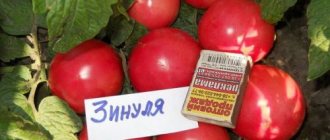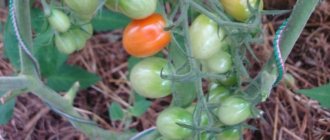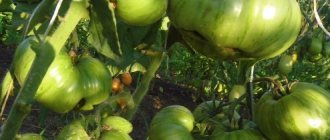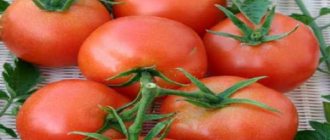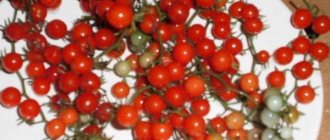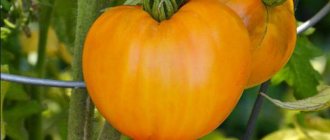Tomatoes are an integral part of the modern human diet. They are included in many first and second courses; they are consumed fresh and processed. Most gardeners grow them on their plots.
Tomatoes with long fruiting are the most popular. They provide the gardener with a harvest from mid-summer until the first frost. Such tomato varieties must be selected with special care. It is at the end of summer that epidemics of plant diseases most often occur. The Sultan tomato is famous for its high immunity. This hybrid is not only resistant to late blight and other infections, but also has a bright, rich taste.
Characteristics of tomatoes
The hybrid belongs to the high-yielding varieties of early maturity.
External differences
Determinate Sultana plants are compact, with an average number of large dark green leaves and simple inflorescences. Each of them produces 5-6 tomatoes.
The flat, rounded fruits have slight ribbing. Unripe tomatoes have a rich green spot around the stalk, which disappears as they ripen.
Ready-to-eat tomatoes have a deep red color with strong skin that protects them from damage and cracking. The pulp is quite dense, tender, with 5-6 pockets, in which there are practically no seeds. Light sourness pleasantly sets off the sweet taste.
Productivity
Sultan bears fruit throughout the season; the last tomatoes are harvested in September. Large fruit - up to 200 g - and high ovary with careful care allow you to harvest up to 560 c/ha of crops, which is 700-100 c/ha higher than regional standards.
Features of application
Tomatoes tolerate transportation and long-term storage well. Excellent taste is well suited for fresh salads or chopped vegetables. Tomatoes have proven themselves excellent in canning and processing: juices, twists and sauces will delight summer residents during the cold season and add variety to the table.
Advantages and disadvantages
The most attractive advantages of the Sultan hybrid include:
- high collection rates;
- quality and size of tomatoes;
- long-term preservation of the crop;
- versatility in application;
- resistance to common fusarium and verticillium;
- compactness and short stature of the bushes.
The disadvantage of the variety is the same for all hybrids - the inability of seeds collected from grown tomatoes to retain parental qualities and produce a harvest.
Tomato variety Sultan (F1)
Tomato Sultan has earned a lot of positive reviews, and all thanks to its excellent taste and high yield.
The originator of the hybrid is the well-known company Bejo Zaden; in Russia the seeds are represented by Agro, Prestige, and Plasma Seeds. Since 2000, it has been included in the State Register of Varieties and is recommended for the Lower Volga, North Caucasus, and Central Black Earth regions.
The Sultan hybrid is part of a large group of determinate tomatoes (having limited growth), the bush grows no more than 60 cm. The foliage is average, the leaf blades are of the usual type, small, and have a rich dark green color. Ripening dates are mid-early, the first fruits can be harvested approximately 95-110 days after emergence (state of technical ripeness). It will take about 12-14 more days to fully ripen on the bushes.
In simple inflorescences of this tomato, from 5 to 7 ovaries are formed. The fruits are round, slightly flattened, having a stalk with an articulation. A slight ribbing is noticeable near the stalk. At the stage of technical maturity, tomatoes are light green in color; in the area of the stalk there may be a prominent dark green spot. When fully ripe, the fruits acquire a bright red color and the stain disappears.
On average, tomatoes vary in weight from 75 to 180 grams. The pulp is quite dense and fleshy (similar to beef tomatoes), the number of seed chambers is from 5 to 8, while the fruit contains a very small number of seeds. The taste is excellent, which is not so common in hybrid forms of tomato. The fruits are used fresh, for salads, and also for processing. Sultan tomatoes are ideal for making juices, sauces, purees, and dressings. The percentage of dry matter is about 4.5%, sugar - 2.8%.
The taste of tomatoes largely depends on growing conditions and correct agricultural technology. This hybrid is recommended for cultivation in unprotected soil (southern regions), as well as in greenhouses and film shelters (middle zone). The yield is on par with the standard; from 1 square meter of plantings you can collect up to 14-15 kg of fruit.
This variety is resistant to a number of traditional tomato diseases: verticillium and fusarium. Due to the mid-early ripening period, it “escapes” late blight.
The advantages of the Sultan tomato include: the ability to obtain fairly large fruits, excellent yield, and high taste. Unlike many similar hybrids, Sultana fruits are suitable for transportation. In addition, they can be stored for up to several weeks without loss of taste and presentation. This variety does not require pinching, but the clusters with ripening fruits need garter and supports. Fruiting is extended, which allows harvesting until autumn. The bushes of this tomato are very compact and low, which is especially convenient for owners with small garden plots.
Among the disadvantages, it should be noted that it is impossible to take your own seeds for sowing for the next season. The offspring of first generation hybrids (F1) do not retain the declared qualities, so if you want to grow Sultan, you will have to purchase seeds every season.
The Sultan tomato is a productive, unpretentious hybrid that will definitely delight you with delicious tomatoes.
Features of cultivation
Like most tomatoes, Sultan requires a seedling method of cultivation.
Selection of seedlings
When choosing seedlings, be sure to consider the following points:
- Opt for strong plants with a developed root system.
- Excessively bright greenery may indicate an excess of nitrogen fertilizers.
- All plants must be healthy. Even if one is clearly infected, the others may be in the incubation period without visible symptoms.
- Ideally, the seedlings are not too tall - up to 30 cm - and have 6-7 true leaves.
- Buy plants no older than 50-60 days without ovary.
- The chances that the bush will take root are greater when transplanted together with nutrient soil;
- It is better to buy seedlings from well-known and trusted suppliers. Check the nuances of growing conditions to ensure the seller’s competence.
Soil and fertilizers
Sultan is not too picky about the soil, but slightly acidic sandy loam or loamy soil fertilized with humus is optimal. Don’t forget about proper crop rotation.
The best predecessors for tomatoes will be melons, legumes, cabbage and cucumbers, and root vegetables. You should not plant them after nightshades.
Tomatoes are very demanding of nutrients: during the period of rhizome development, the need for phosphorus increases, and during flowering and fruiting - for potassium. A lack of nitrogen will slow down growth and affect the quality of the crop and plant immunity. Therefore, it is best to start preparing the soil in the fall: add fertilizers, compost or manure. In the spring, you can supplement the soil with nitrogen-containing additives.
For clay soils, digging with the addition of peat, compost or sand will be useful. Requirement per 1 sq. m:
- 5 kg of peat;
- 8 kg of sand;
- 5 compost or manure.
To reduce soil acidity, use lime, wood ash or chalk. Carry out the alkalization procedure at least 2 weeks before planting.
Growing conditions
Tomatoes are very heat-loving - choose open sunny areas without excess moisture. For adequate growth, the length of daylight hours should not be less than 12 hours, and the comfortable temperature range is 15-35 degrees Celsius. Tomatoes are not so picky about moisture. The beds should be well ventilated and not overly dense.
Tomato hybrid Sultan f1 – among the best in domestic garden beds
In 2008, the famous seed company Bejo Zaden (Holland) introduced its new hybrid variety - the Sultan F1 tomato. The new product was positioned as a hybrid for universal use - for industrial and home greenhouses, as well as for growing in open ground beds.
At the moment, this hybrid is zoned for a number of regions of the Russian Federation - Central Black Earth, Lower Volga and North Caucasus, and was included in the State Register in 2010. This means that in the northern regions the Sultan hybrid tomato can only be grown in greenhouse conditions.
Characteristic features of the tomato variety Sultan f1
Ask and receive useful advice from professional gardeners and experienced summer residents.>>
It belongs to the first generation hybrids, that is, there is no point in collecting seeds from tomatoes - it will not be possible to grow the same ones. You need to buy new seeds every year from the originator, and not from grandmothers on the market or from amateurs.
- Tomato Sultan f1 belongs to the determinant type, the maximum plant height is 60 cm, the bush is compact, medium-leafy. The leaves are medium sized and dark green in color.
- 6 bushes can be planted per 1 square meter, high yield under good growing conditions - 15-18 kg (up to 3 kg per bush).
- The stem is thick and powerful, but requires support due to the large amount of harvest.
- Ripening period is mid-early. The first ripe fruits of Sultana f1, according to reviews, can be obtained 95-100 days after germination or 70 days after planting in a permanent place.
- The clusters are simple, each containing from 5 to 7 tomatoes of different sizes, weighing from 100 to 200 grams.
- When the last cluster is tied, the Sultan f1 tomato bush stops growing and spends all its energy on ripening the crop.
- Fruiting is extended, until autumn.
- The fruits are red, unripe tomatoes are light green, the shape is flat-round, and the stalk has well-defined ribs. There is no green spot.
- The pulp is dense, juicy, there are few seeds.
- Excellent taste - the tomatoes are sweet, tender, with a slight sourness, excellent for salads and preparations. Dry matter content 5%, sugar content up to 3%.
- The skin is thin, but durable, and does not crack with excess moisture and during canning as a whole. Tomatoes are easily transported, have an excellent presentation, and are stored for a long time - more than a month. Picked in the milky ripeness phase, they ripen well.
- Plants are resistant to the main tomato diseases - fusarium, verticillium, and tomato mosaic virus. But during the period when diseases and pests become more active, especially late blight and rot, prevention is necessary in the form of treatments with folk remedies or chemicals such as Zircon, Fitosporin, Trichodermin and their analogues.
Agricultural technology
In general, the cultivation of the Sultan F1 hybrid is standard for determinate varieties. But there are some care features:
Sowing seedlings should be done 50-60 days before planting in open beds. It is irrational to grow this hybrid in greenhouses or use it only as a seal between tall tomatoes.
It is advisable to sow immediately in separate cups, since picking delays the start of fruiting by a week.
To prevent seedlings from stretching, the lighting must be sufficient, and the temperature after emergence must be lowered to 22 degrees.
When planting, the hole must be well filled, the bushes must be deepened a little. The distance between the bushes is at least 40 cm - for good ventilation.
Water only with warm, settled water - cold water can cause the bush to shed its ovaries.
Once every two weeks, plants should be fed with a solution of mineral or organic fertilizers.
The hybrid tolerates short-term drops in night temperatures quite well, without stopping the growth and ripening of fruits. It’s not for nothing that Sultan f1 is included in the best tomato varieties for the Moscow region.
Ripe tomatoes of this type make excellent juice.
Growing seedlings at home
With the proper desire, growing seedlings yourself will not be difficult.
Seed preparation
Seeds from well-known large suppliers are usually processed before being packed into packaging bags. They do not require soaking or disinfection.
If you bought unprocessed seed, there are several preparation points:
- To check germination, dip the seeds in a glass of water with 1 tsp. salt. Throw away any that float.
- To disinfect, keep the seed material in a solution of potassium permanganate (potassium permanganate) for 20 minutes. To do this, dilute 1 g of the drug per liter of water.
- Treat with a growth stimulant to enrich the seeds with nutrients.
Some gardeners carry out the procedure of seed hardening. To do this, rinse the prepared seeds, put them in a bag and place them in a cool place for 3 days, maybe on a refrigerator shelf.
Contents and location
South-facing windows are best suited as a place for seedlings. To maintain sufficient illumination, additionally turn on phytolamps. To compensate for the heating system, mist your plants daily or use a humidifier.
The temperature during the daytime should be 18-25 degrees, and at night - 12-15 degrees Celsius.
Sowing seeds
Sowing is carried out 50-60 days before the approximate planting in the ground. Seedlings can be grown in 2 ways:
- with a pick;
- without diving.
In the first option, the seeds are sown in a shallow container, and after 1-3 true leaves appear, the plants are transplanted into separate forms before planting in the ground. In the second case, the seeds are immediately scattered into pots or cups in which the tomatoes will remain until transplanted into the garden.
Read about how to plant tomato seedlings in the next article.
For sowing, use special purchased soil or prepare it yourself. Mix equal parts soil, peat and humus. You can add 0.5 liters of ash for every 10 liters of the resulting mixture and 40 g of superphosphate.
Disinfect the soil by calcining it in the oven, spilling boiling water or a solution of potassium permanganate.
Fill the containers for seedlings with soil, pour warm water and plant the seeds to a depth of about 1 cm. Then cover the future seedlings with film and leave them warm. The first shoots will appear in 3-5 days.
Be sure to let the soil breathe, periodically removing the covering material.
Seedling care
Caring for seedlings includes watering, adequate lighting, fertilizing and hardening:
- You need to water the soil as it dries with settled water. They must be warm.
- For seedlings to appear, maintain the temperature at 25-28 degrees Celsius; after removing the film, 20-24 will be optimal. On warm days, ventilate the room or take the seedlings to the balcony. Closer to transplantation, harden young tomatoes with open windows or outside, increasing the residence time gradually.
- Seedlings love light; young plants need it for 12-16 hours a day. When there is little natural light, add lamps.
- It is recommended to feed the seedlings for the first time 2-3 weeks after germination. In general, during the growth of seedlings, fertilizing is carried out 3-4 times. Organic or complex mineral fertilizers with phosphorus are best suited for these purposes.
We also recommend reading the article about growing tomato seedlings from seeds.
Transplanting seedlings into the ground
The seedlings are planted in a permanent location after 2 months, when the plant has 6-7 true leaves. The average daily temperature should not fall below +12 degrees Celsius. In the southern regions this is the beginning of May, in the central regions it is closer to the end. Until warm weather sets in, cover the beds with film or other covering material at night.
It is best to transplant in the evening or in cloudy weather so that the tomatoes have time to adapt before the bright sun.
Make holes for plants according to the 40x50 cm pattern. Put fertilizer on the bottom, place the plants, then sprinkle with soil and water the tomatoes.
Description of the tomato Sultan f1 and growing the hybrid
Tomato Sultan f1 belongs to the first generation hybrids. The variety is characterized by early ripening, high productivity, large fruits, and universal use in cooking. The plant is resistant to diseases.
Advantages of a hybrid
The Sultan variety belongs to the selection of Dutch agrobiologists. In 2000, it was included in the Register of Breeding Achievements. The hybrid is recommended for cultivation in the central and southern regions.
The characteristics and description of the variety indicate the possibility of cultivation in open and protected ground. The super early tomato variety Sultan f1 begins to bear fruit 95-110 days after emergence.
The plant is of a determinate type, during the growing season it reaches a height of 50-60 cm. The leaves are medium in size, of the usual type, with an intense green color. The plant forms simple inflorescences. During the growing process it does not require the formation and removal of shoots.
5-7 ovaries are formed in the hands, in which the fruits gradually ripen. The last ovaries can form before the end of the growing season. The weight of the fruit reaches 150-200 g.
The description of the hybrid indicates high yield per bush (up to 4.5 kg). If you follow the rules of agricultural technology, the yield is 15 kg per 1 m².
Tomatoes are medium in size, flat, round in shape, with slight ribbing near the stalk. In the phase of biological ripeness, tomatoes are light green in color, and when ripe they become red.
The fruits have fleshy pulp with a dense consistency. When cut horizontally, small chambers with seeds are observed. Tomatoes have a sweetish taste with a slight sour note. The fruits contain a large amount of amino acids, vitamins, up to 5% dry matter, about 2.8% sugars.
The collected fruits can be stored for a long time. Tomatoes tolerate transportation well over long distances.
Agricultural technology for tomato cultivation
Sowing seeds for seedlings is carried out 55-60 days before planting the seedlings in a permanent place. For planting, carefully prepare a soil mixture containing turf soil and compost. The soil is poured into containers, lightly compacted and grooves 1 cm deep are made.
Typically, seeds from well-known brands contain a special shell that contains the nutrients necessary for the development of the seedling. Therefore, seed material is planted without pre-treatment.
After sowing, watering is carried out with warm water using a sprinkler, and the container is covered with film or glass to create a greenhouse effect. After pecking the seeds, the cover is removed and the container is transferred to a well-lit place. When there is a shortage of lighting, fluorescent lamps are used to extend daylight hours.
For the normal development of seedlings, it is important to ensure temperature conditions, timely watering and fertilizing with complex preparations. At the stage of formation of 2 true leaves, picking is carried out
For this purpose, peat pots are used, into which the substrate is poured.
In such containers, plants are transferred to a permanent place without damaging the root system. This allows the seedlings to easily strengthen and adapt to new conditions. Per 1 m², place up to 6 bushes at a distance of 50 cm from each other.
When growing, the characteristics of the hybrid are taken into account. The variety is characterized by a long fruiting period
This characteristic is taken into account when applying fertilizers.
For example, phosphorus promotes the formation of the root system, nitrogen is responsible for the formation of green mass. Therefore, when determining the component composition of fertilizers, the type of soil and the stage of plant development are taken into account.
Caring for the crop involves timely and moderate watering. For this purpose, warm water is used, which is applied under the root. You can evenly distribute moisture, provide drip irrigation, and prevent the growth of weeds using mulch.
Features of growing in open ground
Growing seeds in open ground has its own nuances.
Open ground conditions
In the south of Russia, it is possible to grow Sultan directly in open ground, but in cooler regions you will need a greenhouse. In warm areas, tomatoes can be planted under cover as early as mid-April, and in open ground by May.
Preparing the soil and choosing a site is no different from what was written above when planting seedlings.
To protect against frost, plantings are covered with film or breathable materials; they can be stretched over arcs. A warm bed, where heat is released during debate, is also perfect.
When planting seeds in greenhouses:
- Before planting, check them for leaks and disinfect them.
- After this, be sure to ventilate it for 5 days.
- Renew the soil if necessary.
- The soil layer should warm up well, so maintain the recommended height - no more than 25 cm.
- Form beds at a distance of about 60 cm from each other and make holes in a checkerboard pattern.
The process of planting seeds in the ground
In mid-April, most often the soil in southern Russia is already warm enough for sowing seeds in the ground.
In the prepared soil, make depressions with a diameter of 35-40 cm and water them with a solution of potassium permanganate. You can sow both sprouted and dry seeds. In case of frost, the dry ones will not die, but will simply sprout later.
Regularly thin out plants sown in open ground:
- After 2-3 true leaves appear, leave the strongest shoots at a distance of 7-9 cm.
- Before the second (4-5 leaves), water the holes thoroughly, again select stronger plants with a distance of about 15 cm. Rejected tomatoes are suitable for transplanting to areas with poor germination.
- During the final thinning, several bushes will remain at a distance of 40 cm.
general description
Tomato Sultan is the development of Dutch breeders. The designation f1 indicates that this is a first generation hybrid, which means that its seeds from its fruits are not suitable for cultivation.
The patent for this hybrid belongs to Bejo Zaden. In our country it is produced by such companies as “Gavrish” and “Plasma Seeds”.
In 2000, Sultan was included in the Russian register. It is recommended for cultivation in the central and southern regions.
Features of the Sultan
Tomato Sultan is a hybrid that is easy to care for. Its compact bushes reach a height of only 50-60 cm. It does not require pinching, which reduces labor costs when growing it.
The fruits are ordinary, red, medium in size. Aligned as in the photo. They have a rich tomato taste with a slightly pronounced sourness, which is not typical for all hybrids. The pulp is dense, tender and juicy.
An important feature of Sultan for gardeners is the duration of fruiting. The first fruits ripen by mid-July, the last ones are removed from the bush in the second half of September.
Immunity is high. The hybrid is not afraid of fungal diseases, tobacco mosaic, and fusarium wilt. Rarely suffers from late blight.
Main characteristics
The Sultan tomato combines the positive characteristics of red-fruited varieties and hybrids. To collect delicious tomato berries all summer long, the gardener does not have to put in too much effort:
| Parameter | Indicators |
| Bush type | Determinate (stops its growth on its own). Not standard. The bushes do not exceed 60 cm in height. The stems are powerful and durable. The amount of foliage is moderate. The leaves are simple, small in size, dark green in color, without pubescence. The first inflorescence is formed in the axil of 5-6 leaves, the next clusters are formed every 2-3 leaves. The fruits are formed in clusters of 5-7 pieces. Up to 6 racemes grow on one plant. |
| Growing method | In the southern regions it is cultivated in open ground. In the central and northern regions - mainly in greenhouses or under film covers. |
| Productivity | High. For the season from 1st quarter. m harvest about 17 kg of crop. |
| Fruit | Medium size. The weight of one berry varies between 100-200 g. The shape is round, flattened at the base. There is light ribbing at the base. Unripe berries are dark green. Ripe - bright red inside and outside without a green spot at the base. The skin is glossy, thin, but durable. The fruits have a large amount of dense but tender pulp. The taste is sweet with sourness. The dry matter content reaches 5%, and the sugar concentration averages 2.8%. One berry has from 6 to 8 chambers. |
| Transportability | High. They do not lose their shape during transportation and are stored for up to a month. |
| Ripening time | Mid-early. The first fruits ripen 100-110 days after sowing the seeds. Fruiting continues until the first frost. |
| Disease resistance | It is immune to most diseases characteristic of nightshade crops. |
Note! The Sultan's taste depends on his agricultural technology. The more sun the plants receive, the sweeter the fruits will be.
Caring for plants in open ground
For a high-quality harvest, planted plants need constant care.
Watering, loosening and weeding
Tomatoes prefer to be watered at the root with settled water at a temperature of at least 18 degrees Celsius. In cool spring weather, the water can be heated to 25 degrees Celsius. Moisture getting on the bushes themselves destroys the flowers and prevents them from setting.
The regularity of watering is determined by the weather: the top layer of soil should not dry out. This happens faster in open ground than in greenhouses. Excess moisture can lead to fungal diseases and rot.
After moistening the soil, it is advisable to loosen it. At the same time, remove weeds. Loosening allows the roots to breathe and receive moisture. This procedure should be carried out at least 2 times a month to a depth of 5 cm.
When the plants grow, along with loosening the soil, also carry out hilling to form adventitious roots.
Stepson and garter
When caring for Sultan tomatoes, pinching will be an important point for the quality of the crop. In determinate plants, 2-3 main stems are formed, removing all the stepsons. Towards the end of August, remove the top, flowers and small ovary to allow larger fruits to ripen and grow.
In warm climates with long summers, tomatoes may not need to be planted.
Sultan's short stature gives misleading ideas about the need for a garter. Inexperienced gardeners may decide that this variety does not need additional support, although this is not the case. Due to the high yield and large fruit, the plants begin to lean toward the ground and may break. To avoid injury to the bushes, use wooden pegs or trellises.
Top dressing
Over the entire growing season, tomatoes are fed 3-4 times. It is recommended to alternate mineral fertilizers with organic matter. Solutions of cow manure (1 to 10) or chicken manure (1 to 15) at the rate of 1 liter per bush are ideal as organic additives.
From mineral ones, choose complex ones containing phosphorus and potassium.
Fertilizers are applied exclusively after watering.
Prevention of diseases and pests
Hybrid Sultan is famous for its resistance to verticillium, fusarium and other standard tomato scourges. But prevention is never superfluous:
- disinfect seeds, soil, tools;
- follow the rules of watering and planting;
- spray the bushes with potassium permanganate or copper sulfate against diseases;
- against pests, use a soap solution, tincture of wormwood or garlic;
- Inspect the plants regularly and remove damaged parts in a timely manner.
We consider the main insects that can cause harm and possible methods of combating them in the table.
| Pest | Treatment |
| Aphid |
|
| Spider mite |
|
| Colorado beetle |
|
| Slugs |
|
| Whitefly |
|
Sultan's agricultural technology
Tomato Sultan in the southern regions is grown in open ground. In cities with cold climates - in greenhouses. In the central lane, both options are possible.
In the southern regions, tomatoes are planted in a permanent place at the beginning of May, in cities with a temperate climate - at the end of May. In the northern part of Russia, seedlings are planted in protected soil at the end of May.
Before planting in a permanent place, the seedlings are fed and watered. Moist soil makes it easier to remove plants.
Planting seedlings in a permanent place
Tomatoes are light-loving plants. The sunniest area of the garden is chosen for them. Beds that did not grow nightshade crops last year are suitable.
The selected place is dug up and cleared of plants. Humus or mullein is added to the soil. If the acidity of the soil is increased, dry lime is added to it. If the soil is too dense, use river sand.
In spring, the beds are leveled with a rake. In the process, they are cleared of weeds. The holes are dug in rows in a checkerboard pattern. For 1 sq. m plant up to six Sultan tomato bushes.
Ash or long-acting fertilizers are poured into the bottom of the holes. After planting the tomatoes, the plants are watered. For each of them take 1 liter of water. The next watering will be possible only after 10 days.
Plant care
Despite their short stature, the plants need to be tied up. Otherwise they will break under the weight of the harvest. Tomatoes are attached to wooden supports or trellises. Synthetic thread is used for garter, as natural material will rot.
There is no need to prun such bushes. They form a small number of shoots, which provide the plant with high yield.
After the first flower cluster has formed, the leaves below it are removed. No more than 3 leaves are picked per week.
Tomatoes should be watered as the soil dries with warm, settled water.
It is important to ensure that the liquid does not fall on the above-ground part of the tomatoes.
After each watering and rainfall, the soil is loosened. During this process, weeds are removed.
Tomatoes are fed 3-4 times during the entire growing season. Alternate organic and mineral compositions. Before fertilizing, you need to water the plants abundantly so as not to burn their roots with fertilizers.
Twice a season, tomatoes are sprayed with foliar fertilizers. Use products containing boron.
Problems during cultivation
When growing tomatoes, gardeners sometimes face a number of problems. The list shows the reasons for some of them:
- A large amount of greenery is formed on the plants, and few ovaries. This indicates that the tomatoes are fattening. The reason is too fertile soil. Reduce the amount of fertilizing.
- Ugly fruits. The most common reasons are violation of watering conditions and temperature conditions, pests.
- Curled leaves. Sign of plant infection. Possible causes are excessive pinching and high humidity.
Diseases and pests
Tomato Sultan is resistant to most tomato diseases. However, he needs disease prevention:
Disinfection. Not only seeds, containers and soil, but also garden tools are treated with disinfectant compounds.
Compliance with the rules of watering and pinching. These procedures are carried out when the sun is inactive
It is important to monitor the humidity level and prevent water from entering the above-ground part of the plants.
Preventive treatments. The bushes are sprayed with a solution of potassium permanganate or copper sulfate.
Protection from harmful insects
Plants are sprayed with a soap solution or wormwood decoction.
Preventive examinations. Held weekly. Damaged bushes are removed.
Harvest and storage
The ripening of the main crop lasts from mid-summer to the last ten days of August. By the end of this period, plants begin to die, their immunity decreases, and the risk of disease increases. To maintain the health and safety of the fruits, it is recommended to collect ripening fruits in early August to reduce the load on the tomatoes.
When the thermometer drops below 8 degrees Celsius and there is a chance of precipitation, all fruits, including green ones, must be collected. After this, the bushes are removed from the site. If the end of summer brings warm weather, the tomatoes will have time to ripen on the plants.
Ripe fresh tomatoes last no longer than 4-5 days; green ones can retain their marketable appearance for several weeks. For long-term storage (up to 2 months):
- select firm and undamaged fruits;
- place them in wooden boxes covered with straw;
- cover with a lid without crushing the tomatoes;
- Place in a dark and cool place with good air access.
Reviews
★★★★★
Stalker-Lg, Lugansk. I bought seeds, the package says that they are from Bejo Zaden.
The characteristics of the variety and a general description are indicated on the packaging; the seeds are processed; you don’t need to do anything else with them. I was attracted by his unpretentiousness and short stature. I really like that it bears fruit for a long time and is not capricious to the weather. ★★★★★
Pioneer-2, Novoaleksandrovsk. I was pleased with the germination of the seeds and planted the seedlings.
A garter wouldn't hurt, but that's how I grew. Large, very happy with the harvest. The description did not deceive. Hide
Add your review
Hybrid tomato varieties combine the best qualities: excellent yield, disease resistance, and fruit quality. Tomato Sultan is one of the brightest representatives of its species. This storehouse of vitamins will always decorate your table and add brightness to every day. Be sure to try it!
0
0
Copy link
Tomatoes: advantages and disadvantages
"Sultan" has the following characteristics:
- Excellent taste;
- High content of sugars, vitamins, amino acids;
Relative disadvantages include the inability to independently collect seed material, as well as the need to purchase it annually.
- High productivity;
- Unpretentiousness;
- Immunity to diseases;
- Ability for long-term storage;
- Possibility of transportation over long distances;
- Extended fruiting period.
